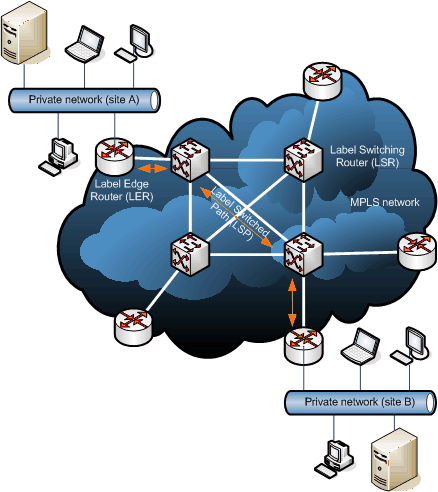Mansoor Majeed gave a presentation last week about multi-protocol label switching (MPLS) to Conchango‘s Infrastructure Architecture community of practice. Mansoor doesn’t have a blog of his own, so I’m taking this opportunity to write a little bit about what I learnt.
I first came across MPLS when I was working for a magazine distribution company in Australia which had expensive frame relay links (running for thousands of kilometres) and were looking at using VPNs across the Internet. The main reason we didn’t go ahead was that it is not possible to ensure quality of service (QoS) for such connections but this is an example of where MPLS would provide similar advantages in terms of routing flexibility, at a lower cost than traditional point-to-point links.
MPLS is a scheme typically used to enhance an IP network, based on Cisco tag switching technology. With tag switching, a switch maintains a map of logical interfaces with a tag for each virtual LAN (VLAN), switching the tag to forward traffic to the appropriate interface. Cisco define tag switching as a:
“High-performance, packet-forwarding technology that integrates network layer (layer 3) routing and data link layer (layer 2) switching and provides scalable, high-speed switching in the network core. Tag switching is based on the concept of label swapping, in which packets or cells are assigned short, fixed-length labels that tell switching nodes how data should be forwarded.”
and MPLS as a:
“Switching method that forwards IP traffic using a label. This label instructs the routers and the switches in the network where to forward the packets based on pre-established IP routing information.”
With MPLS, organisations use their existing network infrastructure to connect to the service provider’s MPLS network, over which services which require QoS can be provided to connect to remote sites.
Switches work at layer 2; routers at layer 3; and as can be seen from Cisco’s tag-switching definition above, MPLS crosses the boundaries of the two layers. MPLS allows traffic routing, combined with the ability to compute a path at source and to distribute information about network topology and attributes. The main constraint is that it uses the shortest path first (SPF) algorithm to calculate the path across the network.
MPLS works by label edge routers (LERs) on the incoming edge of the MPLS network adding an MPLS label to the top of each packet. This label is based on some criteria (e.g. destination IP address) and is then used to pass it through the subsequent label switching routers (LSRs). The LERs on the outgoing edge strip off the label before final delivery of the original packet.

So why invest in MPLS? The main reason is the lower cost for higher performance (e.g. the figures I have seen suggest that bandwidth can be increased 250-500% for a comparable cost) but other advantages include scalability, guaranteed bandwidth, QoS and the fact that MPLS will integrate with any transport method (IP, ATM, frame relay, etc.). Other potential advantages are that the MPLS provider may also provide hosting services, allowing the a company’s public Internet connection to be hosted at the MPLS provider’s datacentre for a minimal cost (cf. the flexibility of managing services locally).
There are some potential disadvantages though, firstly around security (running confidential traffic across a service provider’s network – although this could be encrypted if required); but more significantly there is no partnership at the time of writing between service providers in different countries, so for example, QoS would not be available for UK customers once the traffic left the UK service provider’s network. Over time this may be overcome with a system of MPLS points of presence (PoPs).
Another possible growth area for MPLS is the expansion of voice over Ethernet (VoE) technology. This is not the same as voice over IP (VoIP), but provides a similar service, effectively linking the MPLS network to various telco’s PSTNs. At the moment, a company would typically route all voice traffic via the local telco’s PSTN exchange, with line rental charges per channel connection, per month/quarter. Using VoE, an IP gateway can be used to run voice traffic across the MPLS network up to the point where it needs to transfer to another carrier’s network, resulting in significant savings on the cost of line rental.
That’s just a flavour of what MPLS is about. For further reading, there is a Cisco white paper about MPLS traffic engineering, onestopclick has an MPLS buyers guide and for a view on what to watch out for, there is the Techworld don’t get caught out by MPLS article.
This is a great introduction on MPLS. For more information, check out the wiki page here: Multiprotocol Label Switching
I also found a good brief overview of how MPLS works here: How MPLS Works
-Christopher Wacker
MPLS-Experts
Hi good explanation!
Although I am confused! I am trying to get to grips with the nuances of MPLS technology so please forgive me if I have missed a trick.
I believed that MPLS was used as a mechanism for routing IP packets at Layer 3 & in order to do both most effectively you had to use VPLS (Virtual Private Lan Switching)?
I only have a very simple grasp of this technology so if you could explain this for me I would really appriciate it.
@Mat – it’s not really an area of expertise for me I’m afraid. This post was based on a presentation that a former colleague gave a few years back.